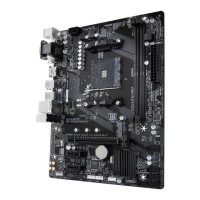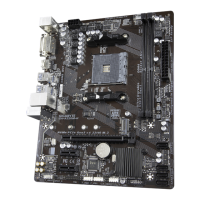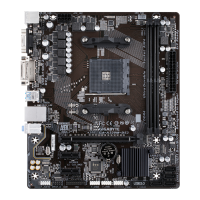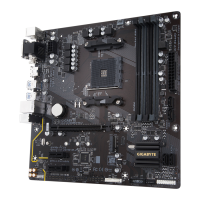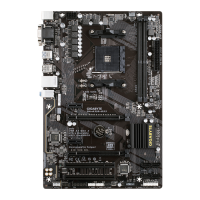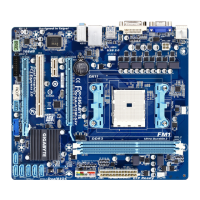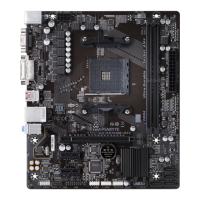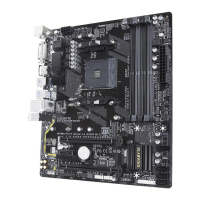Do you have a question about the Gigabyte GA-A320M-S2H and is the answer not in the manual?
Guidelines for safe and proper installation of motherboard and components.
Detailed technical specifications of the motherboard components and features.
Step-by-step instructions for installing the Central Processing Unit (CPU).
Guidance on how to properly install RAM modules into the motherboard slots.
Instructions for inserting PCI or PCIe expansion cards into the motherboard.
Description of external ports and connectors on the motherboard's rear panel.
Identification and description of internal headers and connectors on the motherboard.
Overview of BIOS startup screen and navigation modes (Classic/Easy).
Advanced settings for system performance, frequencies, voltages, and fan control.
Viewing system details, setting date/time, language, and access levels.
Configuration options for boot order, security, and display.
Managing onboard devices, integrated graphics, and chipset features.
Configuring power states, wake-up events, and saving BIOS settings.
Options for saving BIOS settings, loading defaults, and exiting the setup utility.
Step-by-step guide for setting up RAID arrays using onboard SATA controllers.
Instructions for installing essential motherboard drivers and software.
Guidelines for safe and proper installation of motherboard and components.
Detailed technical specifications of the motherboard components and features.
Step-by-step instructions for installing the Central Processing Unit (CPU).
Guidance on how to properly install RAM modules into the motherboard slots.
Instructions for inserting PCI or PCIe expansion cards into the motherboard.
Description of external ports and connectors on the motherboard's rear panel.
Identification and description of internal headers and connectors on the motherboard.
Overview of BIOS startup screen and navigation modes (Classic/Easy).
Advanced settings for system performance, frequencies, voltages, and fan control.
Viewing system details, setting date/time, language, and access levels.
Configuration options for boot order, security, and display.
Managing onboard devices, integrated graphics, and chipset features.
Configuring power states, wake-up events, and saving BIOS settings.
Options for saving BIOS settings, loading defaults, and exiting the setup utility.
Step-by-step guide for setting up RAID arrays using onboard SATA controllers.
Instructions for installing essential motherboard drivers and software.
| ECC | Yes |
|---|---|
| Memory channels | Dual-channel |
| Memory slots type | DIMM |
| Number of memory slots | 2 |
| Supported memory types | DDR4-SDRAM |
| Maximum internal memory | 32 GB |
| Supported memory clock speeds | 2133, 2400, 2667, 2933, 3200 MHz |
| Processor socket | Socket AM4 |
| Processor manufacturer | AMD |
| Compatible processor series | AMD A, AMD Athlon, AMD Athlon X4, AMD Ryzen 3, AMD Ryzen 3 2nd Gen, AMD Ryzen 3 3rd Gen, AMD Ryzen 5, AMD Ryzen 5 2nd Gen, AMD Ryzen 5 3rd Gen, AMD Ryzen 7, AMD Ryzen 7 2nd Gen, AMD Ryzen 7 3rd Gen, AMD Ryzen 9 3rd Gen |
| Maximum number of SMP processors | 1 |
| Number of SATA III connectors | 4 |
| Number of Parallel ATA connectors | - |
| USB 3.2 Gen 2 (3.1 Gen 2) connectors | 0 |
| BIOS type | UEFI AMI |
| ACPI version | 5.0 |
| BIOS memory size | 16 Mbit |
| USB 2.0 ports quantity | USB 2.0 ports have a data transmission speed of 480 Mbps, and are backwards compatible with USB 1.1 ports. You can connect all kinds of peripheral devices to them. |
| Audio chip | Realtek ALC887 |
| Component for | PC |
| Power source type | ATX |
| Motherboard chipset | AMD A320 |
| PC health monitoring | CPU, FAN, Temperature, Voltage |
| Audio output channels | 7.1 channels |
| Motherboard form factor | micro ATX |
| RAID levels | 0, 1, 10 |
| Bundled software | Norton® Internet Security (OEM version) cFosSpeed |
| Harmonized System (HS) code | 84733020 |
| Depth | 195 mm |
|---|---|
| Width | 244 mm |
